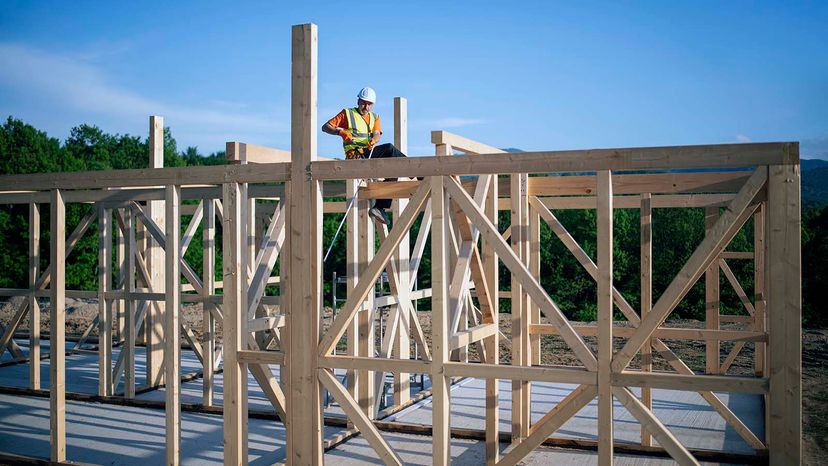
Every construction job is different, but some steps in the process are standard. Your contractor should give you a timeline that's tailored to the house you're building before they break ground. If they don't, ask for one.
Here's what a generic construction timeline might look like [source: Home Building Smart]:
- Pre-construction period. Before you start, you (or your contractor) will likely have to pull permits, finalize architectural plans and get your financing sorted out. This can take one to two months — or longer.
- Preparing the lot and laying the foundation. This includes clearing out debris and trees, leveling out the lot and pouring the foundation. A month is about average for this step.
- Framing the house and building the roof. Framing usually takes about a month, but bad weather can delay things. Once the roof is up — usually a couple of weeks — weather is generally less of a concern [source: Bunzel].
- Siding, wiring and plumbing. Workers will finish the outside of the house and get the plumbing, electrical, and HVAC started, which takes about one or two months.
- Interior finishing. This is when the inside of your house starts to look like a house, with the drywall and most of the carpentry completed. Expect about two months.
- Finish work. In the final two months, contractors install the floors, paint and finish the plumbing and electrical work.
- Punch list. This is a critical step where you do a final walk through, and you and your contractor create what's essentially a to-do list of little things that still need finishing up. Think a paint touch-up here and a bit of caulking there. Make sure you go into this with a critical eye and question anything that seems wrong. This is your chance to get your contractor to fix mistakes before you move in.
- Inspections. During many of these steps, and depending on your county's requirements, you may be required to have inspections by your county inspector. So before your drywall can be hung, for instance, your electrical and plumbing might be required to be inspected. You might also be required to have a final certificate of occupancy inspection to prove your home is built according to the law and codes, and that it is suitable to occupy.
Some of these steps can overlap, of course, and the almost inevitable delays can make the job take painfully longer than anticipated. The problem could be anything from late delivery of materials to the nearly inevitable red tape of inspections and permits. Even knowing that, it might still seem as if things are taking too long. So what can you do?
Prefab: New Construction Without the Wait
If you're looking to move in quickly and avoid some of the time lag and headaches of traditional construction, a prefab home may be for you. Prefabs take only weeks to assemble, rather than months, and they've come a long way in looks since the turn of the last century.
I'm an experienced professional in the field of construction, with a wealth of knowledge in the intricacies of building processes and project management. My expertise is grounded in hands-on experience, having overseen and contributed to a diverse range of construction projects. I've navigated the complexities of obtaining permits, collaborated on architectural plans, and managed the intricate details of construction timelines.
In the context of the article you provided, let's delve into the key concepts:
-
Pre-construction Period:
- During this phase, permits are obtained, architectural plans are finalized, and financing is secured. The duration can range from one to two months or even longer, depending on various factors.
-
Preparing the Lot and Laying the Foundation:
- This step involves clearing debris, leveling the lot, and pouring the foundation. On average, it takes about a month to complete.
-
Framing the House and Building the Roof:
- Framing typically takes a month, but weather conditions can impact the timeline. Once the roof is in place, weather becomes less of a concern.
-
Siding, Wiring, and Plumbing:
- Exterior finishing and the initiation of plumbing, electrical, and HVAC systems take about one to two months to complete.
-
Interior Finishing:
- This phase transforms the interior into a habitable space, involving drywall installation and carpentry work. It generally takes around two months.
-
Finish Work:
- In the final two months, flooring is installed, and final touches are added, including painting and finishing plumbing and electrical work.
-
Punch List:
- A critical step where a final walk-through is conducted, and a to-do list is created for any remaining tasks or touch-ups. It's an opportunity to address any issues before moving in.
-
Inspections:
- Various inspections are required during different construction phases, depending on county regulations. These inspections ensure compliance with building codes and standards. A final certificate of occupancy inspection may also be necessary.
-
Prefab Homes:
- The article suggests an alternative approach to traditional construction with prefab homes. Prefabricated homes offer a quicker assembly process, often taking weeks instead of months. This can be an appealing option for those looking to move in swiftly and avoid some of the challenges associated with traditional construction, such as delays in material delivery and bureaucratic red tape.
By understanding these construction concepts, individuals can better navigate the complexities of building a house and make informed decisions throughout the process.